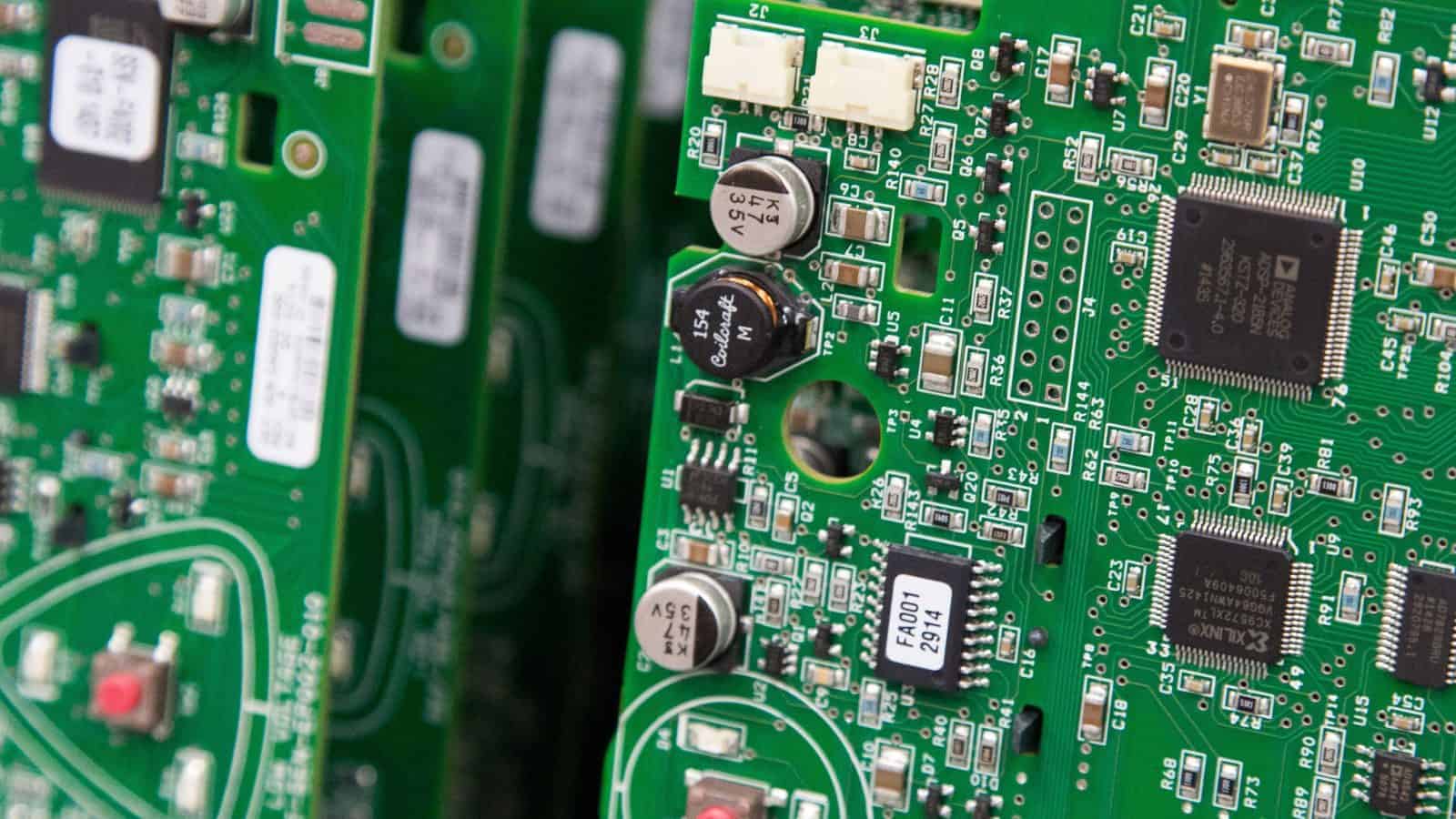40 Years in Manufacturing: An Interview with Former CEO Vicki Holt
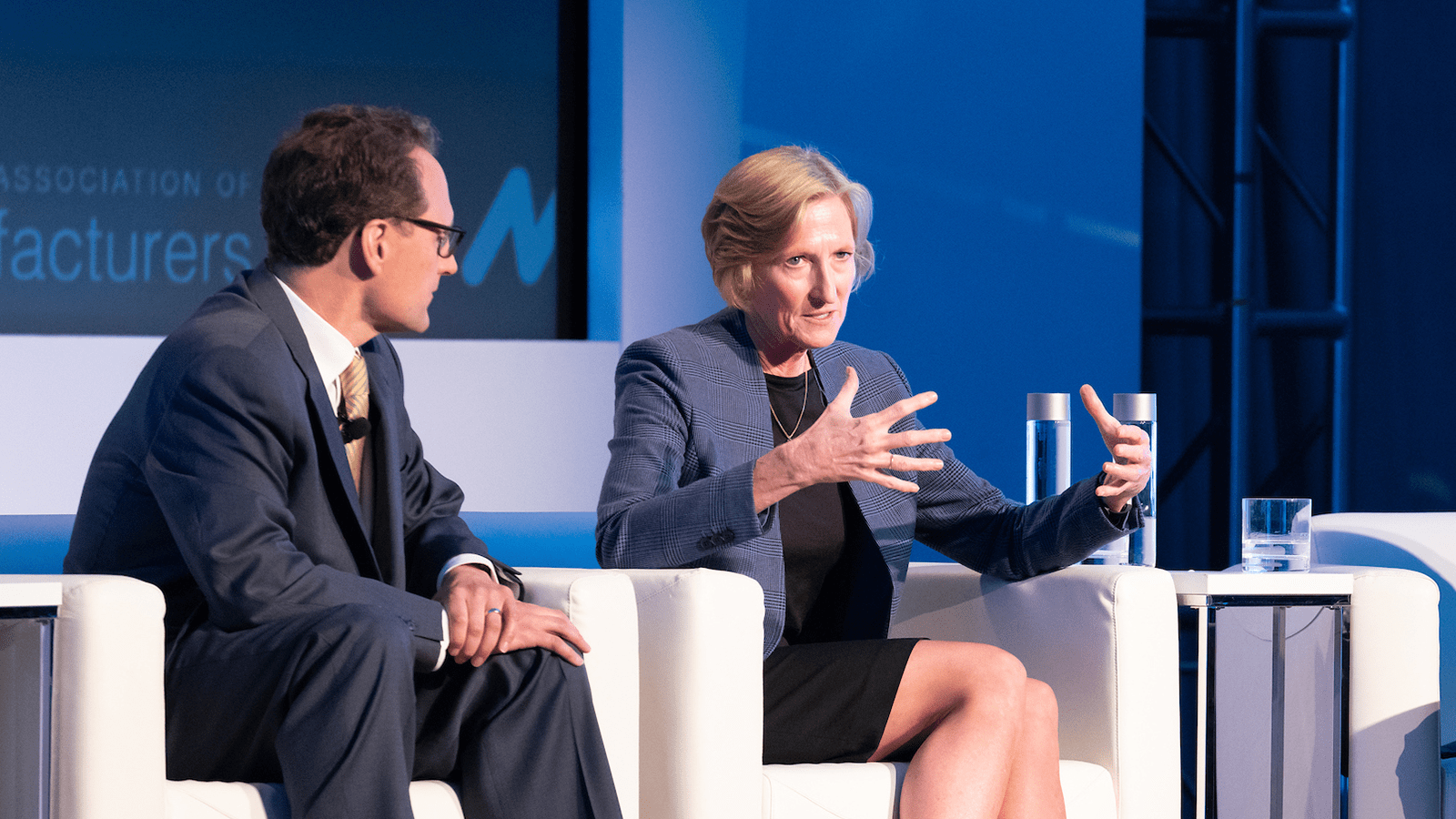
Vicki Holt wants to tell you about digitization. The recently retired CEO of Protolabs, Holt got her start in manufacturing more than 40 years ago and has seen the industry transformed by digital technologies. “By helping manufacturers seize the opportunities of digitization, I believe I am helping them innovate and solve some of the world’s problems,” she explains.
Over the course of her career, Holt led the glass division of PPG, making homes and buildings more energy efficient with solar glazing, then developed sustainable packaging as CEO of Spartech, and from there took charge of digital manufacturing powerhouse Protolabs. We talked to Holt recently about her career, as well as her tenure as the vice chair of the NAM’s Small and Medium-Sized Manufacturers Group, NAM Executive Committee member and as a board member of the NAM’s Manufacturing Leadership Council. Though she has retired from both roles, she remains a key figure in the NAM’s orbit, having recently become a board member at The Manufacturing Institute, the workforce development and education partner of the NAM.
Why the NAM? Holt explains that when she was asked to join the NAM in 2016, she saw it as an opportunity to help manufacturers learn.
- “It was a way for me to get involved and give back, at a time when manufacturing was on the cusp of a new technological revolution,” she says. “I didn’t get involved to influence policy in Washington, but to influence manufacturers themselves.”
By 2017, she had been elected the vice chair of the NAM’s SMM Group, a position she held until her retirement this year. As she notes, the collaboration between the big companies and the smaller ones at the NAM benefits everyone:
- “For example, the big companies were able to dedicate teams to figuring out COVID-19 safety in their factories, and the small and medium-sized companies learned from them. But the big companies also need the smaller ones, because they are essential to supply chains.”
An example of innovation: Holt holds up Protolabs as a prime example of what digitization can do.
- “It used to take companies a long time to innovate, which would stretch out the time for product development. It would take months to make a custom part. Protolabs’ founder broke apart all the things that go into manufacturing a custom injection mold tool and automated the process. What used to take weeks could now be done in a day or two, and all using e-commerce.”
Holt remains an avid watcher of digitization trends, observing that “COVID-19 has accelerated the shift to B-to-B e-commerce throughout the industry, making manufacturers more comfortable connecting to their suppliers digitally.”
Getting manufacturers together: While she was involved with the NAM, Holt also served as a board member of the MLC, which the NAM acquired in 2018 with her encouragement.
- “What I’ve learned through the MLC is that manufacturers are really generous in sharing their learning with other companies,” Holt says. “And that sharing fuels innovation and collaboration.”
- “The MLC complements the NAM,” she adds, “because the NAM is about creating a policy environment that nurtures manufacturing. The MLC is about sharing knowledge about the manufacturing process itself.”
What’s next? Holt is keeping active in retirement. She serves as a board member of several companies—including water heater and treatment maker A.O. Smith Corporation, Waste Management and financial services firm Piper Sandler.
- She is focusing on sustainability in several of these roles and was encouraged to see the Biden administration’s plan for emissions reduction. As she puts it, “If you can unleash manufacturers to innovate, we can reach those targets, even if we don’t have the answers today.”
Holt is also passionate about the mission of the MI:
- “If manufacturers are going to achieve our potential in innovation and digitization, we’ve got to attract people to the industry and show them it’s moved on since the 50s,” she says. “Our frontline employees now solve problems and improve operations in a high-tech environment.”
The last word: Holt says about her time at the NAM, the MLC and the MI, “I’ve just been so impressed with the leaders I’ve met there and their dedication to collaborating and tackling issues like diversity and inclusion. I really appreciate the opportunities afforded to me by being involved in these organizations.”
How One Manufacturer Inactivates COVID-19
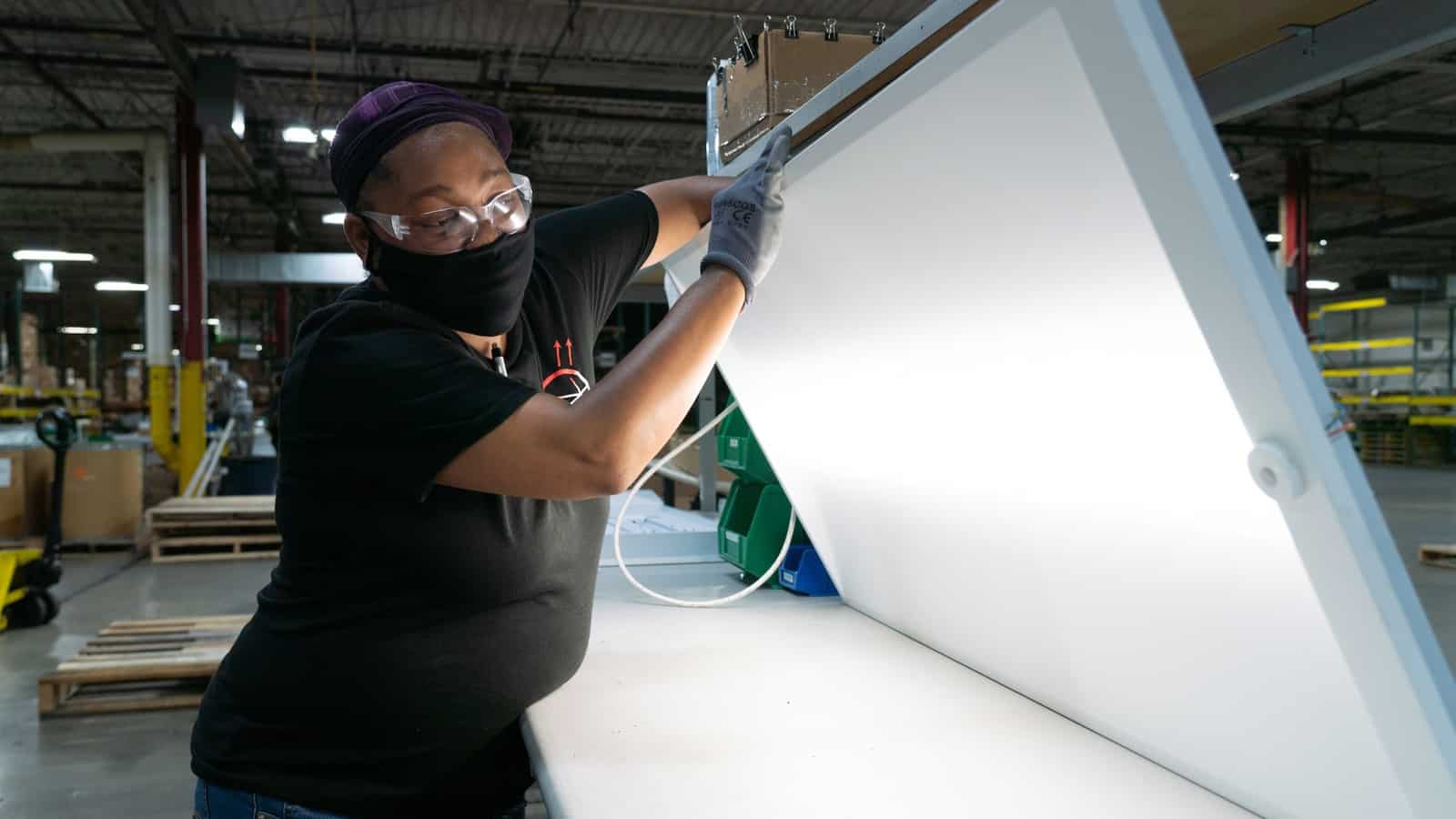
When COVID-19 upended their operations, LumenFocus—a manufacturer of LED light fixtures—saw an opportunity to be of service. It quickly pivoted to developing products that inactivate viruses and kill bacteria with certain UV wavelengths, called UVC wavelengths. These products, which may be used in businesses, schools and hospitals, can make shared environments safer for everyone.
The company’s new solutions also caught the attention of the military. Recently, the Department of Defense awarded LumenFocus a significant portion of a $2.3 million contract to develop a prototype for military operations. LumenFocus President and CEO Charles Kassay said after the announcement, “As an American company, we are thrilled at the opportunity to be developing products to help our servicemen and servicewomen.”
So how did LumenFocus come up with these virus-inactivating fixtures?
How they did it: Before the pandemic, LumenFocus had only manufactured LED light fixtures. But when COVID-19 hit, the company directed its R&D teams to research solutions for eradicating pathogens like COVID-19.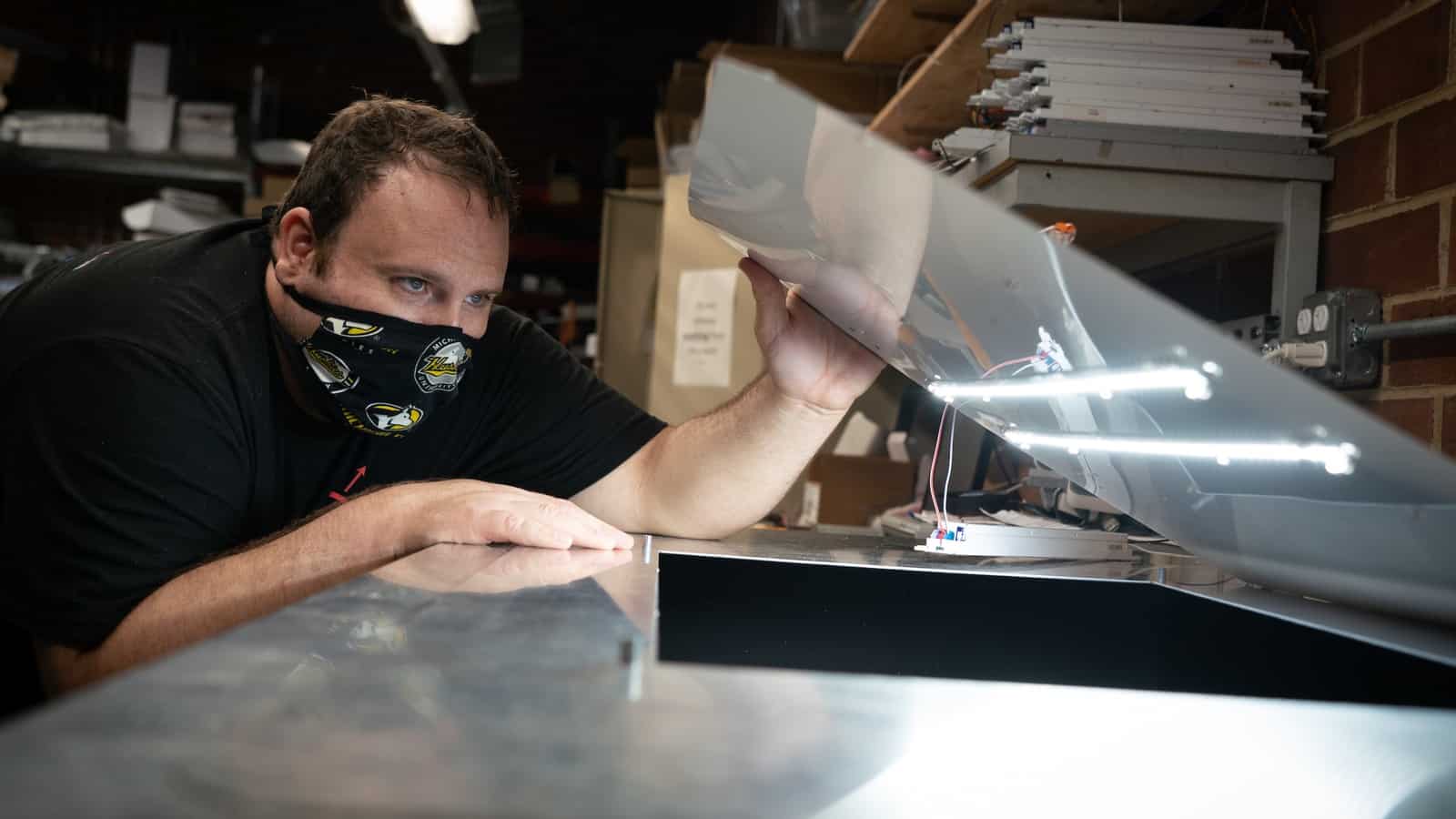
- “We knew about ultraviolet light and its potential for disinfection, but it wasn’t an avenue we had traversed before,” says Marketing Coordinator Eric Robinson. “Once we understood the science behind UV, we combined this with our knowledge and experience in engineering light fixtures, and our fabrication capabilities, to create products for pathogen eradication.”
What they’re making: LumenFocus speedily developed a range of products that offer different means of sanitization for different customers’ needs. Some include:
- The new PathogenFocus product line: These products use nonthermal plasma technology for continuous air and surface disinfection in buildings, either in conjunction with existing HVACs or as standalone units. They have been scientifically proven to reduce up to 99.99% of common pathogens (including bacteria and viruses) quickly and effectively, according to the company.
- Direct UVC units for unoccupied rooms: These products are intended for unoccupied spaces, as they provide a high dosage of UVC to eradicate pathogens quickly. The UVC fixtures can be ceiling mounted or recessed into grid ceilings.
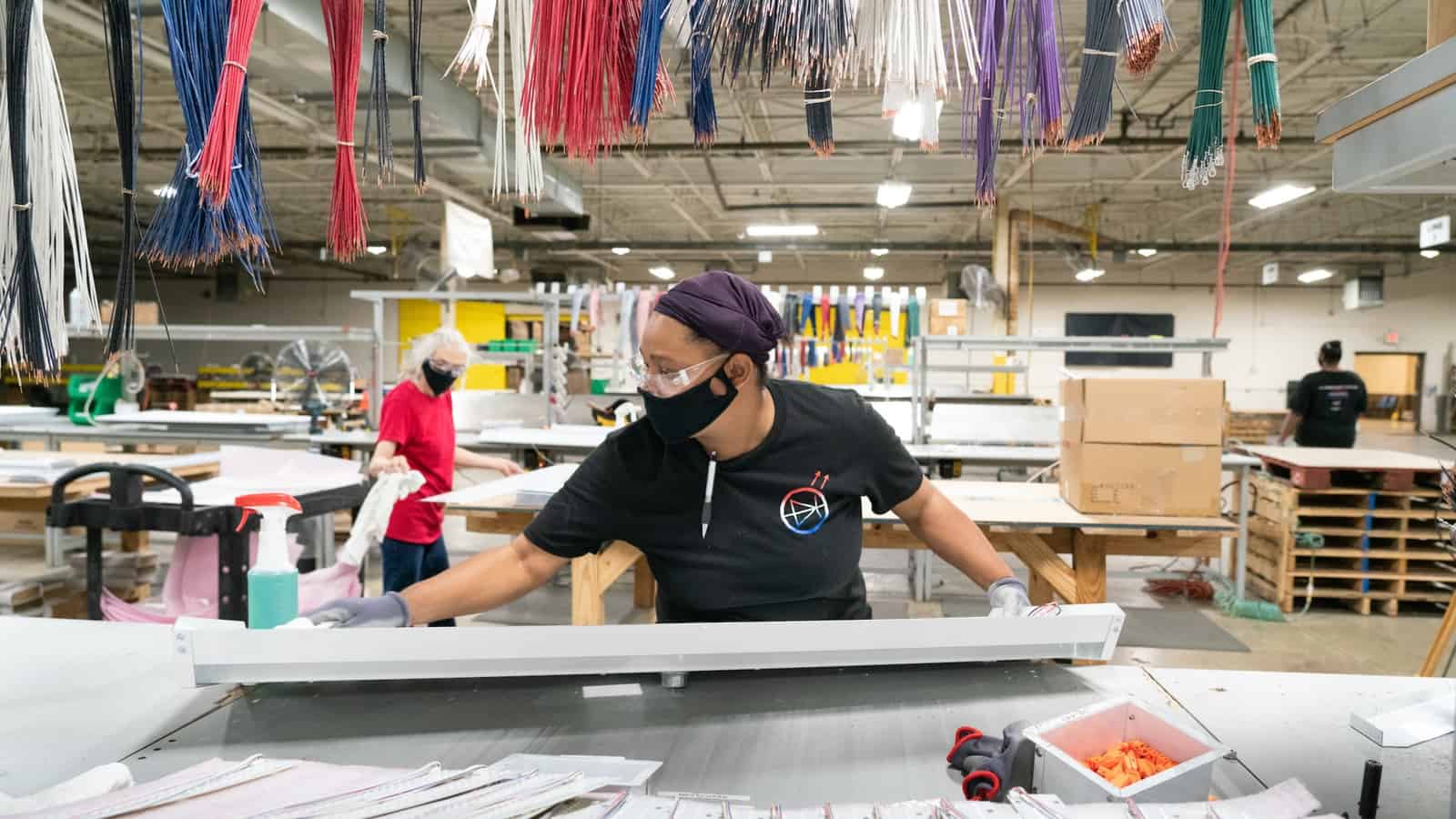
- Germicidal upper air units: These fixtures can be used in occupied spaces, as the UVC treats only the upper zone in the room, not the lower zone where people are. As the air circulates, it flows into the plane of UVC irradiation, where the pathogens are killed or inactivated.
- A portable UVC Tower that can be wheeled around to unoccupied rooms, such as classrooms or offices, and which uses a higher dose of UVC to eradicate viruses and bacteria in a very short time.
The last word: As Kassay says, “The LumenFocus team has been tirelessly working on ways to implement pathogen-eradicating technology. Lighting is just one area where we can help—and that’s an area where we have a lot of experience. Our goal is to develop solutions that will help Americans get back to work in safer, healthier environments. And, if a similar unfortunate situation like COVID-19 arises in the future, we hope that these solutions can help us fight it.”
How Small Manufacturers Can Use Cutting-Edge Tech

As manufacturing goes through digital transformation, small to medium-sized manufacturers have just as much opportunity to reimagine their operations as large businesses. And to help these companies think through their options, the NAM and Stanley Black & Decker got together to host a Creators Wanted virtual session on making use of “Industry 4.0” technologies.
Who participated: NAM President and CEO Jay Timmons, Connecticut Gov. Ned Lamont and Stanley Black & Decker CEO Jim Loree spoke at the event. Other business leaders and government officials, including Connecticut Business & Industry Association President and CEO Chris DiPentima, also joined the session.
Inside Manufacturing 4.0: “All of us want to be a part of Manufacturing 4.0, a fourth Industrial Revolution in manufacturing, powered by digital and smart technology,” said Timmons. “There’s literally no business that can’t benefit from tapping into digital transformation. And today’s event is about demonstrating that keeping your business state of the art, on the cutting edge, is truly easier than you think.”
Why now? U.S. manufacturing is at a pivotal moment and will play a central part in the ongoing economic recovery. Adopting digital tools should be a part of the strategy, according to Loree.
- “As every one of us strives to put the health challenges of the pandemic in the rearview mirror, we all have a responsibility to assist with the economic recovery that must follow,” he said. “Manufacturing must and will play a critical role, and we can supercharge it.”
Getting started: One key tool under discussion was the Smart Industry Readiness Index Assessment, a comprehensive technology evaluation and independent review that can help businesses modernize.
- Bead Industries CEO Jill Mayer said at the event that what she needs as an executive is a snapshot of the current technology landscape and an understanding of her company’s future needs. That’s what a SIRI assessment can deliver.
- The assessment, which takes roughly two days, can help identify technology gaps and inefficiencies, while also helping companies create structured plans for purchasing equipment. The reviews are conducted by certified assessors who understand manufacturing and can help businesses through this key transition.
A broader landscape: In addition to individual innovations and technology, Stanley Black & Decker Chief Technology Officer of Global Operations Sudhi Bangalore cited the importance of innovation and economic manufacturing ecosystems.
- A strong innovation ecosystem can include government experts, upskilling programs, a thriving community of small and medium-sized enterprises and more, according to Bangalore.
- Gov. Lamont added that Connecticut is home to one such ecosystem and cited manufacturing education as a crucial area where government and industry can work together to grow the economy.
Closing thoughts: “I would consider this next year an extraordinary opportunity as we change the way we do business in state government and what we do in manufacturing,” said Gov. Lamont.
To watch the whole session, click here.
How 5G Is Transforming Manufacturing

More than half of all manufacturers will be testing or using fifth-generation cellular wireless technology (aka 5G) in some capacity by the end of 2021, according to a new study from The Manufacturing Institute. The big numbers:
- 91% of manufacturers believe 5G connectivity will be important to the overall future of their businesses.
- 91% of manufacturers indicate speed of 5G deployment will have a positive impact on their ability to compete globally.
- 88% of manufacturers indicate 5G connectivity will allow engineers to troubleshoot remotely.
All-encompassing: 5G is poised to help manufacturers in almost every part of their businesses, according to the study.
- Nine in ten manufacturers expect the utilization of 5G to lead to the creation of new processes (88%) and new businesses (86%). It can make supply chains more efficient and both machines and workers more productive. It also will likely lead to new improvements no one has anticipated yet.
Drilling down: Let’s look at just one facet of 5G’s potential impact: its effects on factory operations. This is how comprehensive the 5G transformation is expected to be:
- Four-fifths of manufacturers indicate 5G technology will be important to inventory tracking (83%), facility security (81%) and warehousing and logistics (81%) within their facilities.
- Three-fourths of manufacturers indicate 5G will also be important to inspection (76%) and assembly (76%) activities, with seven in ten saying packaging (72%) and employee training (71%) efforts will benefit from the deployment of 5G.
And let’s not overlook the fact that more than 90% of manufacturers expect cost savings of approximately 38% from their 5G connections.
Competitive advantage: “Manufacturers’ competitiveness depends on their ability to continuously improve the efficiency and effectiveness of their operations, and disruptive technologies are changing the way that firms innovate and produce,” said the Institute’s Center for Manufacturing Research Director and NAM Chief Economist Chad Moutray.
More information: You can join the Institute for a webinar on 5G technologies on Tuesday, April 6, at 2:00 p.m. ET. Register here.
What It Takes to Manufacture a Vaccine
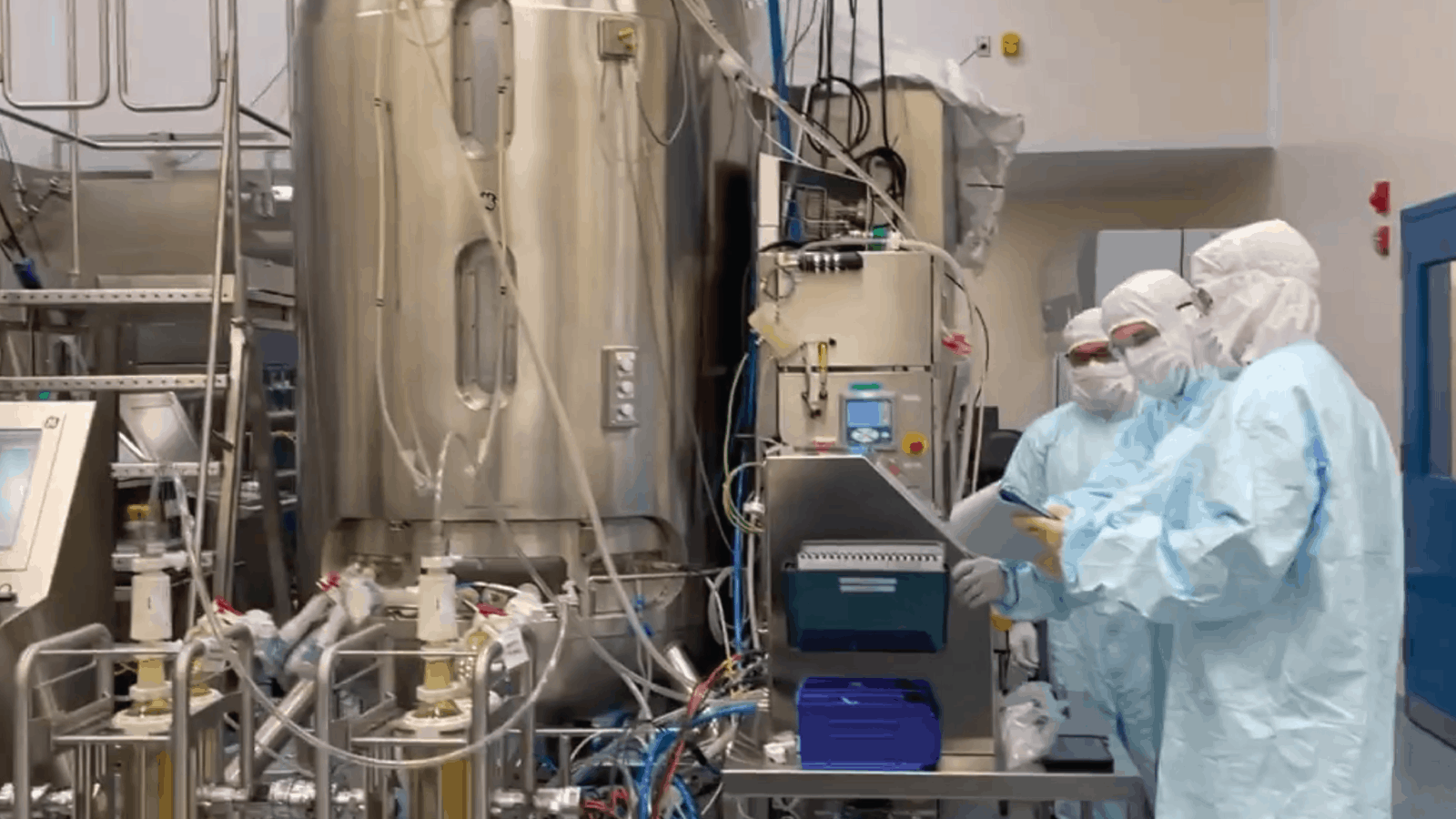
You may not know it, but one company has the capacity to manufacture bulk drug substance for more than a billion doses of COVID-19 vaccines annually: Emergent BioSolutions, a global supplier for the Johnson & Johnson vaccine and U.S. supplier for the AstraZeneca vaccine. Emergent Executive Vice President of Manufacturing and Technical Operations Sean Kirk spoke with us recently to explain what goes into the heroic production of all these doses—in other words, what it takes to help defeat COVID-19.
How the vaccine works: The complexity begins with the vaccines themselves, which are amazing feats of bioengineering. The two vaccines have broadly similar structures, though they are made by separate, quarantined production lines in the Emergent facility. (As Kirk says, you can’t even take a wrench from one production suite to the other.)
You can think of this type of vaccine as a sort of beneficial Trojan Horse:
- Particles of a virus called an adenovirus, which usually causes cold and flu-like symptoms, are engineered to hold the DNA of SARS-CoV-2 (the official name of the coronavirus)—and to not be infectious themselves.
- Those adenovirus particles enter your cells and program them to produce a component of SARS-CoV-2 called a spike protein.
- That process provokes an immune response, teaching your system how to defeat the real COVID-19.
So how do you make it? As you might guess, making such a precise vaccine is itself a complicated and delicate process.
- You need to make a lot of modified adenovirus particles very fast, while ensuring they aren’t infectious and can deliver their payload of SARS-CoV-2 DNA.
- To cut a long story very short, the production process involves “infecting living cells [with the modified adenovirus] and turning them into virus factories,” as science writer Derek Lowe says.
Where Emergent comes in: Emergent handles the manufacturing process, which results in something called “bulk drug substance,” Kirk explains.
- “Our facility produces the high concentration active pharmaceutical ingredients, the viral vectors themselves,” he says. “Then we freeze them down and ship them out to what’s called a fill/finish facility, which dilutes the concentrate and fills vials or syringes with it.”
The numbers: That concentrate will eventually become part of the 100 million Johnson & Johnson doses and 300 million AstraZeneca doses purchased by the U.S. government.
What it takes: Kirk gave us a glimpse of just how much effort went into getting ready for a new vaccine.
- 6 or 7 months: That’s all Emergent had, for a process that normally takes years. Consider how much goes into it, Kirk says: ordering equipment, getting that equipment to work correctly and comply with regulations, “working out the kinks from the complex biological manufacturing process”—and then scaling it up and optimizing it to make large quantities of vaccines as quickly and safely as possible.
- 800 new jobs: Emergent had to increase hiring, adding approximately 800 new jobs in 2020, many of which were dedicated to COVID-19 response across three Maryland sites.
- Group effort: Emergent works incredibly closely with Johnson & Johnson and AstraZeneca, along with the U.S. government and the company’s own suppliers. “We have leveraged U.S. government rated orders to get access to critical raw materials and equipment. We’ve depended upon certain suppliers, who were likewise rallying to the cause, to really step up and ramp up their overall capability and capacity,” says Kirk.
Why can’t you go faster? Kirk says he gets this question all the time and wants to impress upon readers that these are very complex biologic manufacturing processes.
- “They are highly regulated, highly technical and have to be highly reproducible,” he continued. “We are growing living cells and then we are infecting them with these viral vectors.”
- Furthermore, everything that Emergent produces must have the same characteristics of the product used in the clinical trials—“that’s the essence of biologic vaccine development,” Kirk says. “That’s the only way you can ensure safety and efficacy.”
The last word: Kirk tells us what he tells his employees: “It’s unbelievably difficult, more difficult than anything I’ve done in my entire career. But I can’t think of a more awesome opportunity to leave an indelible mark on the course of human history. We are going to help return a degree of normalcy to society. We’re going to help reunite families, open up economies and put a smile on children’s faces when they go back to school. And that’s an honorable and amazing thing.”
This article is the first in an exclusive four-part series on Emergent’s accelerated production efforts.
President Biden Gets to Work, and the NAM Responds

As President Joe Biden took office yesterday, the NAM took a pragmatic stance, calling this new political era “a time for healing.” As NAM President and CEO Jay Timmons put it, “Today, manufacturers recommit ourselves to be part of the solution—to be part of the healing process. We invite all Americans to join us in doing the same.”
And since the new president started his first day with a flurry of executive orders, the NAM responded to those, too. Here’s a rundown of the new policies, plus the NAM’s statements.
Immigration: While also moving to reverse a ban on immigration from certain Muslim-majority countries, President Biden strengthened the Deferred Action for Childhood Arrivals program, offering support to the so-called Dreamers. He called on Congress to pass comprehensive immigration reform that provides Dreamers with permanent status and a path to citizenship.
- Responding to the DACA action, Timmons said, “Manufacturers are very encouraged by today’s critical first step. . . . The broad goals of the Biden plan align with many of the core recommendations in ‘A Way Forward,’ manufacturers’ post-partisan roadmap for immigration reform. The path we have laid out is one that we believe can bring the country together, and we look forward to working with the Biden administration to move a comprehensive immigration reform plan through Congress.”
Keystone XL: President Biden also rescinded the permit for the Keystone XL pipeline, at least temporarily erecting a barrier to its progress.
- “Manufacturers are disappointed with the administration’s decision to block this sustainable project, which can serve as a model for infrastructure of the future, and if not reconsidered, represents a missed opportunity for manufacturing workers in America,” said Timmons. “Manufacturers have a strong commitment to responsible environmental stewardship, and protecting our environment does not require us to walk away from his job-creating opportunity.”
COVID-19: Ten executive orders focused on combating the COVID-19 pandemic, according to CNBC. The NAM had called for aggressive actions to support manufacturers’ COVID-19 response months ago, including in its April “American Renewal Action Plan” and, mostly recently, in conversations with the transition team.
- The orders included a new COVID-19 response office as well as a pandemic supply chain resilience strategy to help strengthen domestic production of important supplies.
- President Biden also restored U.S. membership in the World Health Organization and directed agencies to use the Defense Production Act to spur production of critical materials like N95 masks, swabs and other vaccine- and virus-related equipment.
“It’s very encouraging to see [President Biden] is starting off with strong, decisive action to fight COVID-19, save lives and get our economy on the road to recovery,” said Timmons on Twitter. “Manufacturers are committed to ending this deadly pandemic.”
Masks on: One of President Biden’s orders will now require masks to be worn on federal property, and he plans to require masks on public transportation as well. The NAM has prioritized face coverings since the beginning of the pandemic, including by launching a “Wear a Face Covering” ad campaign and providing a crucial estimate of how many masks American businesses need.
- “President Joe Biden is showing real leadership with his executive orders on masks,” said Timmons. “Masks save lives, help us keep our economy open and are vital until we can all get vaccinated.”
Manufacturers Outline Executive Action Policy Priorities for Incoming Administration
Washington, D.C. – The National Association of Manufacturers called on President-elect Joe Biden to help ensure the future strength of manufacturing in America by extending key executive orders into the new administration and rescinding those that have harmed manufacturing.
“For decades, we have worked with policymakers from across the ideological spectrum to craft policies that encourage the growth of manufacturing in the United States,” said NAM President and CEO Jay Timmons in a letter to the incoming administration. “Now more than ever, America needs leaders in Washington who are focused on increasing American jobs, wages and investment.”
The letter outlines executive orders that have had a significant impact, positive or negative, on manufacturers over the past four years, and it urges the president-elect “to reverse the most harmful of these orders and keep or expand those that create an environment that is conducive to growing America’s manufacturing sector.”
The NAM’s recommendations will help manufacturers continue to respond to the devastating pandemic and will also power the United States’ economic recovery by setting the stage for manufacturing growth.
To read the full letter, click here.
Background:
The NAM has requested President-elect Biden repeal the following executive orders and consider executive orders for extension.
Executive Orders
Rescind:
- “Rescission of the Deferred Action for Childhood Arrivals Program”
- E.O. 13950 – “Combating Race and Sex Stereotyping”
- E.O. 13672 – “Revocation of Federal Contracting”
- E.O. 13769 – “Protecting the Nation from Foreign Terrorist Entry into the United States”
- “President’s Report to Congress on the Proposed Refugee Admissions for FY 21”
- Presidential Proclamation 10052 – “Suspending Entry of Aliens Who Present a Risk to the U.S. Labor Market Following the Coronavirus Outbreak”
- E.O. 13944 – “Ensuring Essential Medicines, Medical Countermeasures and Critical Inputs Are Made in the United States”
- E.O. 13948 – “Lowering Drug Prices by Putting America First”
- E.O. 13957 – “Creating Schedule F in the Excepted Service”
Extend:
- E.O. 13771 – “Reducing Regulation and Controlling Regulatory Costs”
- E.O. 13805 – “Establishing a Presidential Advisory Council on Infrastructure”
- E.O. 13766 – “Expediting Environmental Reviews and Approvals for High-Priority Infrastructure Projects”
- E.O. 13845 – “Continuing the President’s National Council for the American Worker and the American Workforce Policy Advisory Board”
- E.O. 13932 – “Modernizing and Reforming the Assessment and Hiring of Federal Job Candidates”
- E.O. 13777 – “Enforcing the Regulatory Reform Agenda”
- E.O. 13806 – “Assessing and Strengthening the Manufacturing and Defense Industrial Base and Supply Chain Resiliency of the United States”
- E.O.s – “Strengthening the Federal Government’s Anti-Counterfeiting Efforts”
-NAM-
The National Association of Manufacturers is the largest manufacturing association in the United States, representing small and large manufacturers in every industrial sector and in all 50 states. Manufacturing employs more than 12.3 million men and women, contributes $2.32 trillion to the U.S. economy annually and has the largest economic multiplier of any major sector and accounts for 62% of private-sector research and development. The NAM is the powerful voice of the manufacturing community and the leading advocate for a policy agenda that helps manufacturers compete in the global economy and create jobs across the United States. For more information about the NAM or to follow us on Twitter and Facebook, please visit www.nam.org.
Say “Ahhh”: A Manufacturer Makes It Safe for Dentists to Reopen
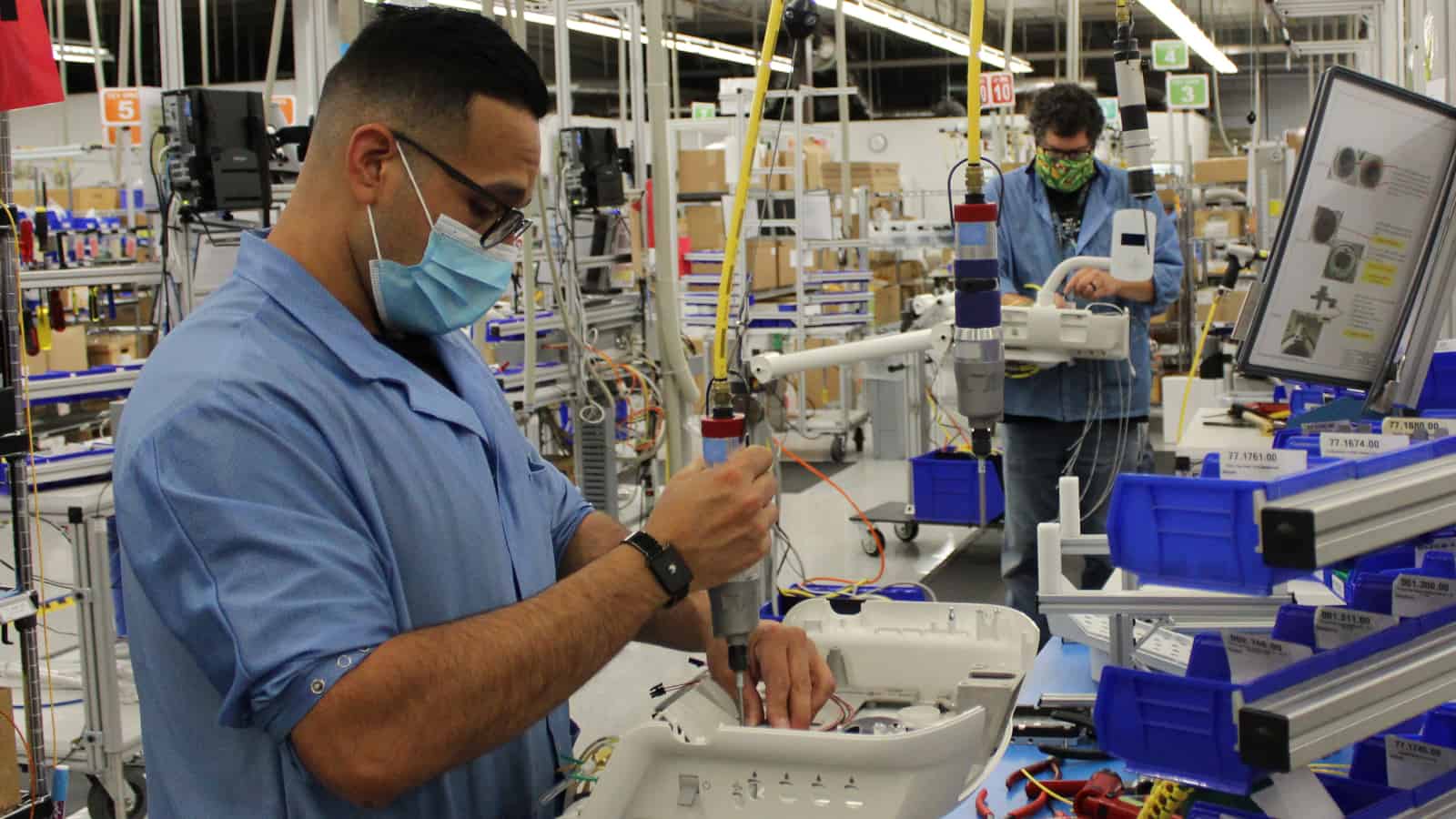
What do you do when a pandemic shuts down your customers? That was the problem faced by A-dec, a manufacturer of dental equipment and supplies based in Oregon, when dentists nationwide closed their doors back in March.
In A-dec’s case, they developed products to help their core customers come back safely.
The problem: Dentists and hygienists are at particular risk of contracting COVID-19 while treating patients, because their jobs require proximity to their patients’ open mouths.
- Dentists also use loupes with lights and magnifiers to see inside patients’ mouths—but wearing medical masks and traditional face shields makes it difficult to wear lighted loupes as well.
- Meanwhile, traditional face shields are open at the bottom—and because dentists work on patients who recline right below them, those shields provide limited protection.
The solution: A-dec’s engineers got to work designing and producing a unique face shield for dentists that fits around the collarbone and opens upwards, providing a barrier between dentists and patient. The shield also leaves additional space around dentists’ eyes so they can use lighted loupes.

The process: The same pandemic that made this work necessary also made it difficult. A-dec had to overcome a series of complications:
- Research and development: COVID-19 made the company’s customer focus groups impossible to do in person, so it designed and conducted remote focus group sessions.
- Sourcing of materials. Shortages and supply chain disruptions also caused problems, with some commodities becoming unavailable at the last minute. That meant A-dec faced delays and had to find alternate sources of materials at times.
- Product construction. Like many other manufacturers, A-dec had to figure out how to keep remote workers and on-site, socially distancing workers in sync with each other—all while creating a new product in record time.
By working around these setbacks and streamlining its processes, A-dec was able to go from the initial idea to the beginning of production in just two months—an extraordinary achievement.
The last word: According to A-dec Vice President of Manufacturing Wesley Snyder, the company benefited from its familiarity with medical regulations—but that doesn’t mean non-medical manufacturers can’t make a difference. “Everything is made by somebody, and the manufacturing industry is uniquely positioned to make tangible contributions to society in a crisis like this,” he said. “So find those new points of need, and align them with your capabilities.”
The U.S. Needs Better Broadband Access

Most of us are extremely grateful to have the internet nowadays—it keeps manufacturers’ high-tech operations running and provides entertainment for our socially distanced evenings. But the U.S. needs continued, substantial investment in broadband access and will do so long after the pandemic is over. One reason, of course, is that manufacturing is increasingly high-tech and high-skilled, which means demand will keep rising for fast, reliable and universal connectivity.
So in light of our renewed appreciation of all things digital, here’s a quick reminder of the policies that the NAM is promoting, courtesy of NAM Director of Innovation Policy Stephanie Hall. As she puts it, the federal government needs to take the following steps:
- Modernize federal partnership programs and appropriate funds to increase broadband deployment in hard-to-serve areas and to close the digital divide.
- Fund broadband mapping efforts to help us understand where broadband is needed and who needs it most.
- Create a smart regulatory environment that allows the private sector to design, build, finance, operate and maintain our digital infrastructure.
Recent actions: The NAM—and manufacturers across the country—are calling on Congress to include broadband funding in its COVID-19 response. In a May letter to the Senate Committee on Commerce, Science and Transportation, the NAM asked Congress to “support investment in our broadband infrastructure system, maximize consumer choice in how they connect and reduce regulatory barriers that can slow manufacturers’ ability to deploy current and next-generation broadband infrastructure.”
As Congress continues to work on COVID-19 response funding, the NAM will keep pushing for broadband access.
Can Antibody Find Me…A Treatment for COVID-19

Manufactured antibody treatments could be the next big thing in the fight against COVID-19, Reuters reports. The therapy is often used against illnesses like cancer, and a range of biotech companies are working together to test this approach.
Who’s involved: Several companies have been allowed by the U.S. government to combine resources to manufacture supplies, should any of the companies’ drugs succeed. Those companies include Eli Lilly and Company, AstraZeneca, Amgen and GlaxoSmithKline.
Meanwhile, The Wall Street Journal (subscription) reports on a Lilly study involving antibody drugs in nursing homes.
- The study, which aims to enroll up to 2,400 subjects in nursing homes and other long-term care facilities, is intended to test whether the company’s antibody drug can reduce rates of infection.
- If the study is successful, Lilly hopes its drug could receive government approval by the year’s end.
Go deeper: Revisit our recent writeup of an important new study on America’s effective policies for pharma development—and how these should be preserved.
